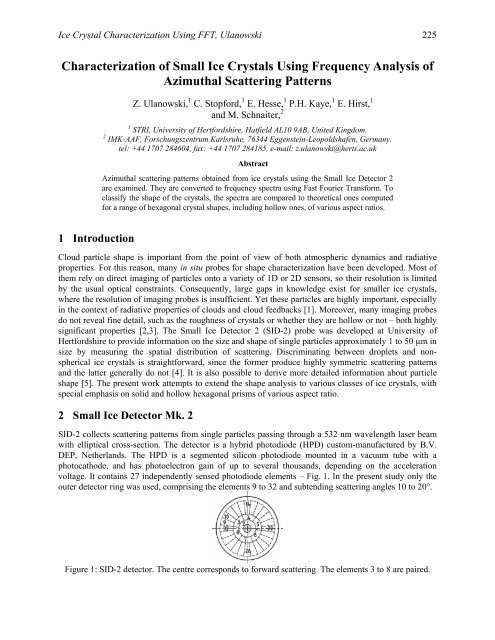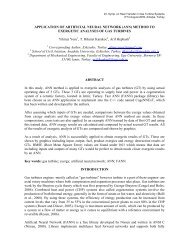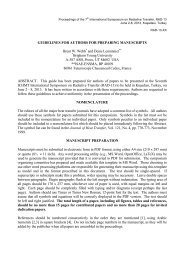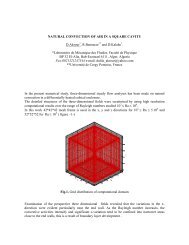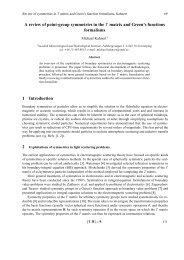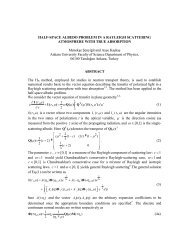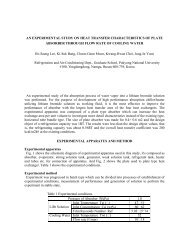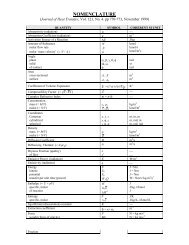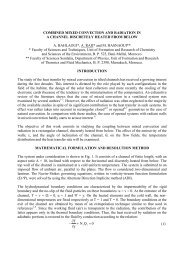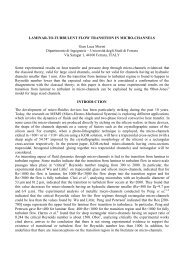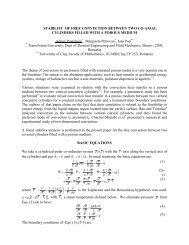Characterization of Small Ice Crystals Using Frequency Analysis of ...
Characterization of Small Ice Crystals Using Frequency Analysis of ...
Characterization of Small Ice Crystals Using Frequency Analysis of ...
Create successful ePaper yourself
Turn your PDF publications into a flip-book with our unique Google optimized e-Paper software.
<strong>Ice</strong> Crystal <strong>Characterization</strong> <strong>Using</strong> FFT, Ulanowski 225<br />
<strong>Characterization</strong> <strong>of</strong> <strong>Small</strong> <strong>Ice</strong> <strong>Crystals</strong> <strong>Using</strong> <strong>Frequency</strong> <strong>Analysis</strong> <strong>of</strong><br />
Azimuthal Scattering Patterns<br />
Z. Ulanowski, 1 C. Stopford, 1 E. Hesse, 1 P.H. Kaye, 1 E. Hirst, 1<br />
and M. Schnaiter, 2<br />
1 STRI, University <strong>of</strong> Hertfordshire, Hatfield AL10 9AB, United Kingdom.<br />
2 IMK-AAF, Forschungszentrum Karlsruhe, 76344 Eggenstein-Leopoldshafen, Germany.<br />
tel: +44 1707 284604, fax: +44 1707 284185, e-mail: z.ulanowski@herts.ac.uk<br />
Abstract<br />
Azimuthal scattering patterns obtained from ice crystals using the <strong>Small</strong> <strong>Ice</strong> Detector 2<br />
are examined. They are converted to frequency spectra using Fast Fourier Transform. To<br />
classify the shape <strong>of</strong> the crystals, the spectra are compared to theoretical ones computed<br />
for a range <strong>of</strong> hexagonal crystal shapes, including hollow ones, <strong>of</strong> various aspect ratios.<br />
1 Introduction<br />
Cloud particle shape is important from the point <strong>of</strong> view <strong>of</strong> both atmospheric dynamics and radiative<br />
properties. For this reason, many in situ probes for shape characterization have been developed. Most <strong>of</strong><br />
them rely on direct imaging <strong>of</strong> particles onto a variety <strong>of</strong> 1D or 2D sensors, so their resolution is limited<br />
by the usual optical constraints. Consequently, large gaps in knowledge exist for smaller ice crystals,<br />
where the resolution <strong>of</strong> imaging probes is insufficient. Yet these particles are highly important, especially<br />
in the context <strong>of</strong> radiative properties <strong>of</strong> clouds and cloud feedbacks [1]. Moreover, many imaging probes<br />
do not reveal fine detail, such as the roughness <strong>of</strong> crystals or whether they are hollow or not – both highly<br />
significant properties [2,3]. The <strong>Small</strong> <strong>Ice</strong> Detector 2 (SID-2) probe was developed at University <strong>of</strong><br />
Hertfordshire to provide information on the size and shape <strong>of</strong> single particles approximately 1 to 50 µm in<br />
size by measuring the spatial distribution <strong>of</strong> scattering. Discriminating between droplets and nonspherical<br />
ice crystals is straightforward, since the former produce highly symmetric scattering patterns<br />
and the latter generally do not [4]. It is also possible to derive more detailed information about particle<br />
shape [5]. The present work attempts to extend the shape analysis to various classes <strong>of</strong> ice crystals, with<br />
special emphasis on solid and hollow hexagonal prisms <strong>of</strong> various aspect ratio.<br />
2 <strong>Small</strong> <strong>Ice</strong> Detector Mk. 2<br />
SID-2 collects scattering patterns from single particles passing through a 532 nm wavelength laser beam<br />
with elliptical cross-section. The detector is a hybrid photodiode (HPD) custom-manufactured by B.V.<br />
DEP, Netherlands. The HPD is a segmented silicon photodiode mounted in a vacuum tube with a<br />
photocathode, and has photoelectron gain <strong>of</strong> up to several thousands, depending on the acceleration<br />
voltage. It contains 27 independently sensed photodiode elements – Fig. 1. In the present study only the<br />
outer detector ring was used, comprising the elements 9 to 32 and subtending scattering angles 10 to 20°.<br />
Figure 1: SID-2 detector. The centre corresponds to forward scattering. The elements 3 to 8 are paired.
226 Tenth International Conference on Light Scattering by Non-spherical Particles<br />
3 Theoretical scattering patterns<br />
Two dimensional (2D) scattering patterns have been computed using the Ray Tracing with Diffraction<br />
on Facets (RTDF) model [6,7]. The fundamental shape was a hexagonal prism with basal faces replaced<br />
by inverted (hollow) hexagonal pyramids <strong>of</strong> varying depth: 0, 10, 25 and 49% <strong>of</strong> the prism length. The<br />
aspect ratio (length to diameter) <strong>of</strong> the prisms was 3, 1 and 0.2, to represent columns, compact prisms and<br />
thin plates, respectively – giving 12 classes in total. For each shape, 2D scattering patterns for 40 different<br />
orientations were computed - Fig. 2. The central dark area in the 2D plot in Fig. 2 is due to the exclusion<br />
<strong>of</strong> the scattering on the projected outline <strong>of</strong> the particle, which in the current versions <strong>of</strong> the RTDF model<br />
is computed as Fraunh<strong>of</strong>er diffraction on a circular aperture, which would not represent 2D scattering<br />
correctly. However, this region is not seen by the outer ring <strong>of</strong> the SID-2 detector, so the present analysis<br />
is not affected. The 2D patterns were converted to the SID-2 detector outer-ring responses by integrating<br />
over corresponding angles, to give 24-element azimuthal scattering patterns. The patterns were then<br />
converted to angular frequency spectra using fast Fourier transform (FFT) and taking the magnitude <strong>of</strong><br />
the Fourier coefficients <strong>of</strong> order 1 to 12 normalized to the coefficient <strong>of</strong> order 0 – Fig. 2.<br />
Figure 2: (left) Scattering computed for a prism with 25% basal indentations: 2D pattern extending up to<br />
45°. (centre) Corresponding polar plot <strong>of</strong> square root <strong>of</strong> the outer ring response, and FFT coefficients<br />
(order 1-12) for the pattern. (right) FFT spectra for the 12 prism shapes averaged over 40 orientations -<br />
the aspect ratio decreases from left to right and the cavity depth from bottom to top.<br />
Figure 3: Fitted solution matrix for the 12 computed classes <strong>of</strong> hexagonal prisms, with 40 orientations in<br />
each class, and corrupted by random noise with signal to noise ratio <strong>of</strong> 2.4 (left) and 1.8 (right).
<strong>Ice</strong> Crystal <strong>Characterization</strong> <strong>Using</strong> FFT, Ulanowski 227<br />
As a test, each shape class (40 orientations) <strong>of</strong> the theoretical FFT spectra was corrupted by adding<br />
varying amounts <strong>of</strong> random noise and fitted using a least squares method to uncorrupted spectra. This<br />
procedure produced 12x12 “solution matrices” giving proportions <strong>of</strong> spectra assigned to each class. It was<br />
found that the spectra were classified correctly even for large noise levels, but with increasing “leakage”<br />
into wrong classes for increasing noise – Fig. 3. The solution matrices were algebraically inverted to<br />
produce “deconvolution” matrices for each noise level, to allow the correction <strong>of</strong> solution sets.<br />
4 Measurements<br />
4.1 <strong>Ice</strong> analogue measurements<br />
SID-2 scattering patterns were recorded from ice analogue crystals [2,8] by ejecting single crystals from a<br />
needle electrode [9]. Examples are shown in Fig. 4, together with the corresponding FFT spectra.<br />
Figure 4: Azimuthal scattering patterns (left) and FFT spectra (right) from 5 ice analogue prisms and a 4-<br />
arm rosette (lower right corner).<br />
4.2 AIDA cloud chamber measurements<br />
<strong>Ice</strong> crystal measurements were done at the AIDA cloud chamber <strong>of</strong> Forschungszentrum Karlsruhe during<br />
the HALO-01 ice nucleation campaign in March 2007. AIDA can be operated as an expansion cloud<br />
chamber to study the formation <strong>of</strong> ice clouds down to temperatures <strong>of</strong> about -90°C [10]. During<br />
experiment 17 hexagonal plates were grown at temperature <strong>of</strong> –28°C and low supersaturation by injecting<br />
seed ice crystals into the chamber. FFT spectra from SID-2 data at time=910s were fitted to theoretical<br />
spectra from the 12 shape classes using a least squares method, and then deconvolved. The solutions<br />
were consistent with the presence <strong>of</strong> thick plates with 10% cavities – Fig. 5.<br />
Figure 5: Crystal shape classification for HALO-01 exp. 17 obtained by fitting FFT spectra.
228 Tenth International Conference on Light Scattering by Non-spherical Particles<br />
4 Conclusion<br />
A theoretical database <strong>of</strong> 2D light scattering patterns for 12 classes <strong>of</strong> hexagonal prisms with different<br />
aspect ratios and cavity depth was computed using the RTDF method. The 2D patterns were converted<br />
into azimuthal ones and then into angular frequency spectra using FFT. The spectra were found to be<br />
characteristic <strong>of</strong> particle shape and they can be used as a basis for shape classification, even for data<br />
strongly contaminated by noise. Experimental spectra from ice crystals were obtained using the SID-2<br />
probe in the AIDA cloud chamber and fitted using a least squares method to the database to derive ice<br />
crystal shape. The shape classification can be improved by a deconvolution <strong>of</strong> solutions using inverted<br />
theoretical solution matrices obtained for levels <strong>of</strong> noise characteristic <strong>of</strong> the given experimental<br />
conditions.<br />
Acknowledgments<br />
This work was carried out with funding from the Natural Resources Research Council, with further<br />
support from the European ACCENT network.<br />
References<br />
[1] T. J. Garrett, H. Gerber, D. G. Baumgardner, C. H. Twohy, and E. M. Weinstock, “<strong>Small</strong>, highly<br />
reflective ice crystals in low-latitude cirrus,” Geophys. Res. Lett, 30, 2132 (2003).<br />
[2] Z. Ulanowski, E. Hesse, P. H. Kaye and A. J. Baran, “Light scattering by complex ice-analogue<br />
crystals,” J. Quantit. Spectr. Rad. Transf. 100, 382-392 (2006).<br />
[3] C. G. Schmitt, J. Iaquintaa, and A. J. Heymsfield, "The asymmetry parameter <strong>of</strong> cirrus clouds<br />
composed <strong>of</strong> hollow bullet rosette-shaped ice crystals from ray-tracing calculations," J. Appl.<br />
Meteor. Climat. 45, 973-981 (2006).<br />
[4] E. Hirst, P. H. Kaye, R. S. Greenaway, P. R. Field, and D. W. Johnson, “Discrimination <strong>of</strong><br />
micrometre-sized ice and super-cooled droplets in mixed-phase cloud,” Atmos. Environ. 35, 33-47<br />
(2001).<br />
[5] E. Hirst, P. H. Kaye, and Z. Wang-Thomas, “A Neural Network based Spatial Light Scattering<br />
Instrument for Hazardous Airborne Fiber Detection,” Appl. Opt. 36, 6149-6156 (1997).<br />
[6] A. J. M. Clarke, E. Hesse, Z. Ulanowski, and P. H. Kaye, “A 3D implementation <strong>of</strong> ray tracing<br />
combined with diffraction on facets,” J. Quantit. Spectr. Rad. Transf. 100, 103-114 (2006)<br />
[7] E. Hesse, A. J. M. Clarke, Z. Ulanowski and P. H. Kaye, “Light scattering by ice crystals modelled<br />
using the Ray Tracing with Diffraction on Facets method,” EGU General Assembly, Vienna<br />
(2007).<br />
[8] Z. Ulanowski, E. Hesse, P. H. Kaye, A.J. Baran, R. Chandrasekhar, “Scattering <strong>of</strong> light from<br />
atmospheric ice analogues,” J. Quantit. Spectr. Rad. Transf. 79-80C, 1091-1102 (2003).<br />
[9] E. Hesse, Z. Ulanowski, and P. H. Kaye, “Stability characteristics <strong>of</strong> cylindrical fibres in an<br />
electrodynamic balance designed for single particle investigation,” J. Aerosol Sci. 33, 149-163<br />
(2002).<br />
[10] O. Möhler, P. R. Field, P. Connolly, S. Benz, H. Saath<strong>of</strong>f, M. Schnaiter, R. Wagner, R. Cotton, M.<br />
Krämer, A. Mangold, A.J. Heymsfield, “Efficiency <strong>of</strong> the deposition mode ice nucleation on<br />
mineral dust particles,” Atmos. Chem. Phys. 6, 3007–3021 (2006).


